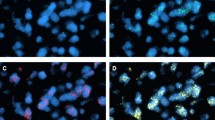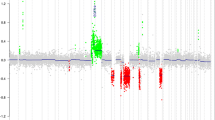Abstract
The aim of this study was to evaluate the clinical value of assessing epidermal growth factor receptor (EGFR) amplification and the common 5′ rearrangement of EGFR resulting in the EGFRvIII transcript in astrocytic gliomas. Data from 221 tumours were correlated with patient survival. The majority of previous studies evaluated amplification alone and provided contradictory results. Amplification was analysed by a densitometry of Southern blot analysis or quantitative polymerase chain reaction (PCR). EGFR transcripts were examined by reverse transcription PCR and subsequent sequencing. A ribonuclease (RNase) protection assay was carried out on a subgroup to confirm PCR results. Amplification of EGFR was found in 41% (65/160) of glioblastomas (GBs) and 10% (4/41) of anaplastic astrocytomas (AAs). The EGFRvIII rearrangement was identified in 54% (35/65) of GBs and 75% (3/4) of AAs with amplification, as well as in 8% (8/95) of GBs and 5% (2/37) of AAs without amplification (confirmed by RNase protection assay). There were no abnormalities of the EFGR or its transcript in grade II astrocytoma (AII). We found no significant association between EGFR amplification or rearrangement, and age or survival in the 160 GB patients. We noted a tendency towards decreased survival with any EGFR abnormality in the 41 patients with AAs. This was most marked in the five cases with the EGFRvIII transcript (p=0.069), but these were significantly older than those without (p=0.023). No abnormalities of EGFR were identified in AII patients. We conclude that neither EGFR amplification nor the presence of the EGFRvIII transcript predicts patient outcome in conventionally treated GBs. However, in AAs, although uncommon, EGFR aberrations appear to be associated with shorter survival.



Similar content being viewed by others
References
Schlessinger J (2000) Cell signaling by receptor tyrosine kinases. Cell 103:211–225
Yarden Y, Sliwkowski MX (2001) Untangling the ErbB signalling network. Nat Rev Mol Cell Biol 2:127–137
Ekstrand AJ, Sugawa N, James CD, Collins VP (1992) Amplified and rearranged epidermal growth factor receptor genes in human glioblastomas reveal deletions of sequences encoding portions of the N- and/or C-terminal tails. Proc Natl Acad Sci U S A 89:4309–4313
Moscatello DK, Holgado-Madruga M, Godwin AK, Ramirez G, Gunn G, Zoltick PW, Biegel JA, Hayes RL, Wong AJ (1995) Frequent expression of a mutant epidermal growth factor receptor in multiple human tumours. Cancer Res 55:5536–5539
Salomon DS, Brandt R, Ciardiello F, Normanno N (1995) Epidermal growth factor-related peptides and their receptors in human malignancies. Crit Rev Oncol Hematol 19:183–232
Sugawa N, Ekstrand AJ, James CD, Collins VP (1990) Identical splicing of aberrant epidermal growth factor receptor transcripts from amplified rearranged genes in human glioblastomas. Proc Natl Acad Sci U S A 87:8602–8606
Wong AJ, Ruppert JM, Bigner SH, Grzeschik CH, Humphrey PA, Bigner DS, Vogelstein B (1992) Structural alterations of the epidermal growth factor receptor gene in human gliomas. Proc Natl Acad Sci U S A 89:2965–2969
Humphrey PA, Wong AJ, Vogelstein B, Zalutsky MR, Fuller GN, Archer GE, Friedman HS, Kwatra MM, Bigner SH, Bigner DD (1990) Anti-synthetic peptide antibody reacting at the fusion junction of deletion-mutant epidermal growth factor receptors in human glioblastoma. Proc Natl Acad Sci U S A 87:4207–4211
Backlund LM, Nilsson BR, Goike HM, Schmidt EE, Liu L, Ichimura K, Collins VP (2003) Short postoperative survival for glioblastoma patients with a dysfunctional Rb1 pathway in combination with no wild-type PTEN. Clin Cancer Res 9:4151–4158
Galanis E, Buckner J, Kimmel D, Jenkins R, Alderete B, O’Fallon J, Wang CH, Scheithauer BW, James CD (1998) Gene amplification as a prognostic factor in primary and secondary high-grade malignant gliomas. Int J Oncol 13:717–724
Tohma Y, Gratas C, Biernat W, Peraud A, Fukuda M, Yonekawa Y, Kleihues P, Ohgaki H (1998) PTEN (MMAC1) mutations are frequent in primary glioblastomas (de novo) but not in secondary glioblastomas. J Neuropathol Exp Neurol 57:684–689
Olson JJ, Barnett D, Yang J, Assietti R, Cotsonis G, James CD (1998) Gene amplification as a prognostic factor in primary brain tumours. Clin Cancer Res 4:215–222
Smith JS, Tachibana I, Passe SM, Huntley BK, Borell TJ, Iturria N, O’Fallon JR, Schaefer PL, Scheithauer BW, James CD, Buckner JC, Jenkins RB (2001) PTEN mutation, EGFR amplification, and outcome in patients with anaplastic astrocytoma and glioblastoma multiforme. J Natl Cancer Inst 93:1246–1256
Kleihues P, Cavanee WK (2000) WHO classification of tumours, pathology and genetics of the nervous system. IARC Press, Lyon
Ekstrand AJ, James CD, Cavenee WK, Seliger B, Pettersson RF, Collins VP (1991) Genes for epidermal growth factor receptor, transforming growth factor alpha, and epidermal growth factor and their expression in human gliomas in vivo. Cancer Res 51:2164–2172
Liu L, Ichimura K, Pettersson EH, Collins VP (1998) Chromosome 7 rearrangements in glioblastomas; loci adjacent to EGFR are independently amplified. J Neuropathol Exp Neurol 57:1138–1145
Frederick L, Wang XY, Eley G, James CD (2000) Diversity and frequency of epidermal growth factor receptor mutations in human glioblastomas. Cancer Res 60:1383–1387
Shinojima N, Tada K, Shiraishi S, Kamiryo T, Kochi M, Nakamura H, Makino K, Saya H, Hirano H, Kuratsu J, Oka K, Ishimaru Y, Ushio Y (2003) Prognostic value of epidermal growth factor receptor in patients with glioblastoma multiforme. Cancer Res 63:6962–6970
Ohgaki H, Dessen P, Jourde B, Horstmann S, Nishikawa T, Di Patre PL, Burkhard C, Schuler D, Probst-Hensch NM, Maiorka PC, Baeza N, Pisani P, Yonekawa Y, Yasargil MG, Lutolf UM, Kleihues P (2004) Genetic pathways to glioblastoma: a population-based study. Cancer Res 64:6892–6899
Huncharek M, Kupelnick B (2000) Epidermal growth factor receptor gene amplification as a prognostic marker in glioblastoma multiforme: results of a meta-analysis. Oncol Res 12:107–112
Ichimura K, Schmidt EE, Goike HM, Collins VP (1996) Human glioblastomas with no alterations of the CDKN2A (p16INK4A, MTS1) and CDK4 genes have frequent mutations of the retinoblastoma gene. Oncogene 13:1065–1072
Ichimura K, Schmidt EE, Yamaguchi N, James CD, Collins VP (1994) A common region of homozygous deletion in malignant human gliomas lies between the IFN alpha/omega gene cluster and the D9S171 locus. Cancer Res 54:3127–3130
Gehan EA (1965) A generalized two-sample Wilcoxon test for doubly censored data. Biometrika 52:650–653
Ekstrand AJ, Longo N, Hamid ML, Olson JJ, Liu L, Collins VP, James CD (1994) Functional characterization of an EGF receptor with a truncated extracellular domain expressed in glioblastomas with EGFR gene amplification. Oncogene 9:2313–2320
Aldape KD, Ballman K, Furth A, Buckner JC, Giannini C, Burger PC, Scheithauer BW, Jenkins RB, James CD (2004) Immunohistochemical detection of EGFRvIII in high malignancy grade astrocytomas and evaluation of prognostic significance. J Neuropathol Exp Neurol 63:700–707
Baselga J (2001) Targeting the epidermal growth factor receptor: a clinical reality. J Clin Oncol 19:41S–44S
Jungbluth AA, Stockert E, Huang HJ, Collins VP, Coplan K, Iversen K, Kolb D, Johns TJ, Scott AM, Gullick WJ, Ritter G, Cohen L, Scanlan MJ, Cavenee WK, Old LJ, Cavanee WK (2003) A monoclonal antibody recognizing human cancers with amplification/overexpression of the human epidermal growth factor receptor. Proc Natl Acad Sci U S A 100:639–644
Masui H, Kawamoto T, Sato JD, Wolf B, Sato G, Mendelsohn J (1984) Growth inhibition of human tumor cells in athymic mice by anti-epidermal growth factor receptor monoclonal antibodies. Cancer Res 44:1002–1007
Sampson JH, Crotty LE, Lee S, Archer GE, Ashley DM, Wikstrand CJ, Hale LP, Small C, Dranoff G, Friedman AH, Friedman HS, Bigner DD (2000) Unarmed, tumor-specific monoclonal antibody effectively treats brain tumors. Proc Natl Acad Sci U S A 97:7503–7508
Quang TS, Brady LW (2004) Radioimmunotherapy as a novel treatment regimen: 125I-labeled monoclonal antibody 425 in the treatment of high-grade brain gliomas. Int J Radiat Oncol Biol Phys 58:972–975
Han Y, Caday CG, Umezawa K, Nanda A (1997) Preferential inhibition of glioblastoma cells with wild-type epidermal growth factor receptors by a novel tyrosine kinase inhibitor ethyl-2,5-dihydroxycinnamate. Oncol Res 9:581–587
Han Y, Caday CG, Nanda A, Cavenee WK, Huang HJ (1996) Tyrphostin AG 1478 preferentially inhibits human glioma cells expressing truncated rather than wild-type epidermal growth factor receptors. Cancer Res 56:3859–3861
Phillips PC, Levow C, Catterall M, Colvin OM, Pastan I, Brem H (1994) Transforming growth factor-alpha–Pseudomonas exotoxin fusion protein (TGF-alpha–PE38) treatment of subcutaneous and intracranial human glioma and medulloblastoma xenografts in athymic mice. Cancer Res 54:1008–1015
Brady LW, Miyamoto C, Woo DV, Rackover M, Emrich J, Bender H, Dadparvar S, Steplewski Z, Koprowski H, Black P et al (1992) Malignant astrocytomas treated with iodine-125 labelled monoclonal antibody 425 against epidermal growth factor receptor: a phase II trial. Int J Radiat Oncol Biol Phys 22:225–230
Acknowledgements
We thank the Departments of Neurosurgery and Pathology at the Karolinska University Hospital, Sahlgrenska University Hospital, and many other hospitals in Sweden that helped us obtain follow-up data.
Author information
Authors and Affiliations
Corresponding author
Additional information
This work was supported by grants from The Cambridge Fund for the Prevention of Disease, Cancer Research UK, The Ludwig Institute for Cancer Research, Jacqueline Serousse Memorial Foundation for Cancer Research and the Swedish Children’s Cancer Foundation
Rights and permissions
About this article
Cite this article
Liu, L., Bäcklund, L.M., Nilsson, B.R. et al. Clinical significance of EGFR amplification and the aberrant EGFRvIII transcript in conventionally treated astrocytic gliomas. J Mol Med 83, 917–926 (2005). https://doi.org/10.1007/s00109-005-0700-2
Received:
Accepted:
Published:
Issue Date:
DOI: https://doi.org/10.1007/s00109-005-0700-2




